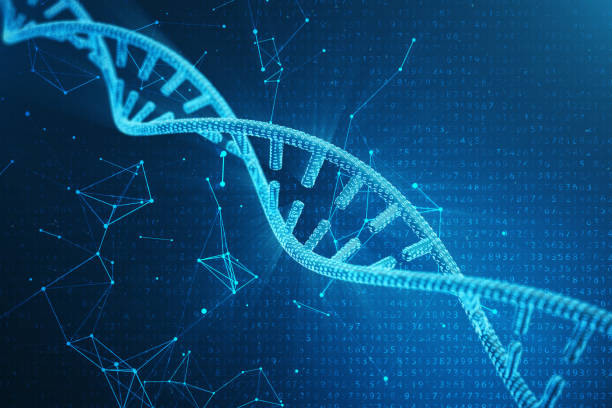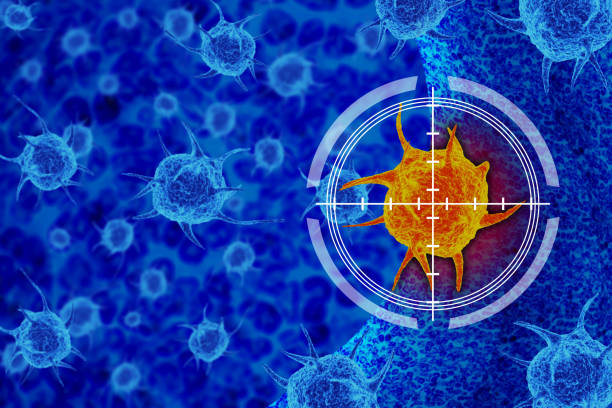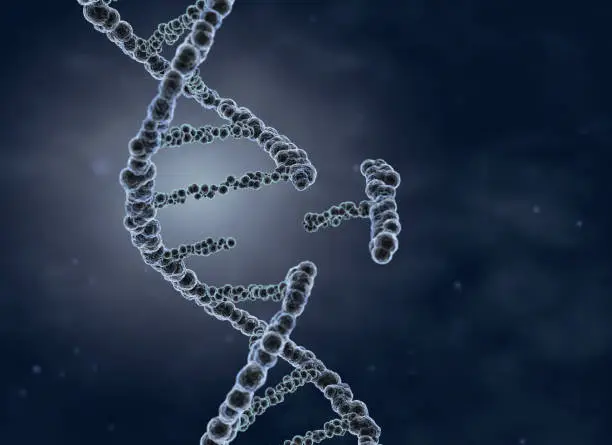In the intricate world of cellular biology, tumor suppressor genes serve as vigilant guardians, ensuring that our cells grow, divide, and die in a controlled manner. Imagine your body as a secured facility with numerous checkpoints to ensure everything functions smoothly. Tumor suppressor genes act like built-in defenses against cancer, acting like security systems to prevent harmful entities from infiltrating and causing damage. These genes are crucial for maintaining the delicate balance within our cells. When they function properly, they keep everything in check. However, when these genes are compromised, the consequences can be dire, often resulting in the uncontrolled cell growth that characterizes cancer.

What Are Tumor Suppressor Genes?
Tumor suppressor genes are a specialized group of genes that are essential for inhibiting cell proliferation and preventing tumor formation. They function similarly to brakes in a vehicle, slowing or stopping cell division when necessary, repairing DNA damage, and ensuring that cells only grow and divide when needed. While oncogenes can lead to cancer when they are overactive, tumor suppressor genes help prevent cancer by maintaining genomic stability when they function correctly. But when these genes are damaged or turned off, the brakes fail, and cells can grow uncontrollably.
How Do Tumor Suppressor Genes Work?
These genes play several key roles in maintaining cellular control:
- Regulating Cell Division: Tumor suppressor genes ensure that cells only divide when conditions are favorable. If there’s a problem with the cell, these genes can pause cell division, allowing time for repairs before the cell continues to grow.
- DNA Repair: These genes help fix any damage to the cell’s DNA. If the damage isn’t repaired, it can lead to mutations that may cause cancer.
- Triggering Cell Death (Apoptosis): Sometimes, a cell is too damaged to be fixed. In these cases, tumor suppressor genes can trigger apoptosis to eliminate potential threats.
- Guiding Cell Differentiation: Some tumor suppressor genes help cells mature into their specific roles, preventing them from reverting to a less specialized, more chaotic state where they might start dividing uncontrollably.
Key Tumor Suppressor Genes and Their Roles
Here are some of the most important tumor suppressor genes:
- TP53 (p53): Often called the “guardian of the genome,” p53 is like a master controller. It detects DNA damage and can stop cell division or trigger apoptosis. Mutations in TP53 are found in over 50% of all cancers, making it a key target in cancer prevention and treatment.
- RB1 (Retinoblastoma Protein): RB1 acts as a gatekeeper, ensuring that cells don’t proceed with division unless everything is in order. Mutations in RB1 are linked to retinoblastoma(a childhood eye cancer) and various other cancers.
- BRCA1 and BRCA2: These genes are essential for DNA repair. Mutations here increase the risk of breast, ovarian, and other cancers, making genetic testing and monitoring crucial.
- PTEN: This gene helps regulate cell growth and is frequently mutated in the prostate, brain, and endometrial cancers.
- APC: The APC gene is critical for controlling cell growth in the colon. Mutations are common in colorectal cancer, highlighting the importance of regular screenings.
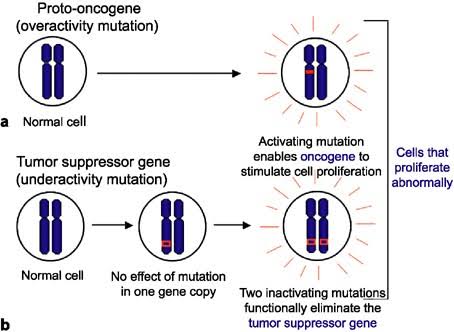
Mechanisms of Tumor Suppressor Gene Inactivation
Cancer typically develops when tumor suppressor genes are inactivated or lost. This inactivation removes the cellular safeguards that prevent uncontrolled growth and allows mutations to accumulate, ultimately leading to cancer. Several mechanisms can lead to the inactivation of tumor suppressor genes:
- Two-Hit Hypothesis: Most loss-of-function mutations in tumor suppressor genes are recessive, meaning both copies of a tumor suppressor gene must be inactivated for cancer to develop—a concept known as the “two-hit hypothesis.” Alfred Knudson first proposed this idea to explain why some people inherit a higher risk of cancer; they may be born with one mutated copy of a tumor suppressor gene, requiring just one more mutation for cancer to develop
- Loss of Heterozygosity (LOH): This is a process where a cell loses its remaining healthy copy of a tumor suppressor gene. Without this backup, the cell can no longer keep cancer at bay.
- Point Mutations: Point mutations can result in the production of a dysfunctional protein or the complete loss of protein expression. IIn tumor suppressor genes, a single point mutation can disrupt the gene’s ability to control cell growth and division, resulting in unchecked cell proliferation.
- Gene Deletions: Complete or partial deletions of tumor suppressor genes can eliminate their protective effects.
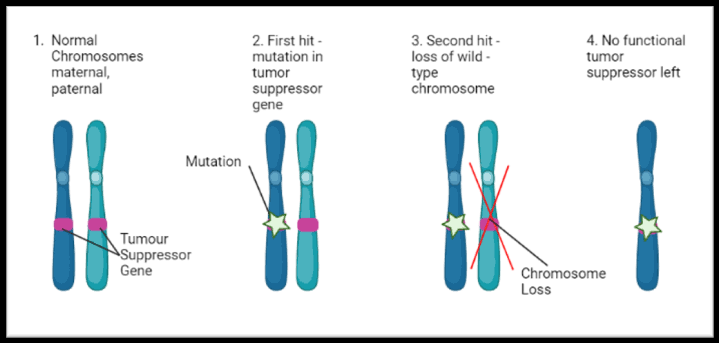
Tumor Suppressor Genes and Cancer Therapy: Restoring the Guardians
The inactivation of tumor suppressor genes presents significant challenges for cancer therapy, as reactivating a lost or mutated gene is not as straightforward as inhibiting an overactive oncogene. However, understanding the role of these genes in cancer has led to several promising strategies aimed at restoring their function or compensating for their loss:
- Gene Therapy: Restoring the function of mutated or inactivated tumor suppressor genes through gene therapy is a promising approach. Scientists are working on ways to deliver functional copies of tumor suppressor genes to cancer cells, aiming to restore their protective role. While gene therapy is still in its early stages, advancements in this field could lead to new treatments that precisely target cancer cells with inactivated tumor suppressor genes.
- Targeting Downstream Pathways: When direct repair of the gene isn’t possible, targeting the pathways it controls might be an effective way to halt cancer progression.
For example; PTEN mutation leads to hyperactivation of the P13/AKT/mTOR pathway which promotes cell survival and growth. Drugs like Everolimus(mTOR inhibitor) and Alpelisib(P13 inhibitor) are used in cancers with PTEN mutations.
- Synthetic Lethality: This approach targets cancer cells that have lost a specific tumor suppressor gene by blocking another pathway they rely on to survive. By inhibiting this secondary pathway, researchers can selectively kill cancer cells while sparing normal cells. For example; PARP(poly ADP ribose polymerase) inhibitors like Olaparib which target DNA repair pathways, are used in cancers with BRCA mutations.
- Combination Therapies; Targeting tumor suppressor genes in combination with other cancer therapies, such as chemotherapy or immunotherapy, may enhance treatment efficacy.
- Preventive Strategies: For individuals with inherited mutations in tumor suppressor genes, regular screenings, preventive surgeries, or medications can significantly reduce the risk of developing cancer.
The Future: New Frontiers in Cancer Research
The fight against cancer is advancing with exciting research focusing on:
- p53 Reactivation: Scientists are developing small molecules that can fix or mimic the function of mutant p53, offering new hope for treating cancers where this gene is damaged.
- Disrupting Protein Interactions: By targeting the interactions between proteins essential for tumor suppressor function, new treatments might be able to kill cancer cells selectively.
- Cancer Vaccines: Researchers are exploring vaccines that could train the immune system to recognize and attack cells with tumor suppressor gene mutations, offering a personalized approach to cancer treatment.
Conclusion: The Role of Tumor Suppressor Genes in Cancer Treatment
Tumor suppressor genes are essential in maintaining cellular control and preventing cancer. When these genes are lost or inactivated, it can lead to uncontrolled cell growth and cancer development. Understanding the mechanisms of these genes and finding ways to restore or compensate for their loss is a major focus of cancer research. Continued research is essential to unlocking new frontiers in cancer prevention and treatment. With ongoing advancements in gene therapy, targeted treatments, and new therapeutic approaches, there is hope for more effective cancer treatments.
Further Readings
Sherr, C. J. (2004). Principles of Tumor Suppression.
Levine, A. J. (1997). p53, the Cellular Gatekeeper for Growth and Division.
Knudson, A. G. (2001). Two genetic hits (more or less) to cancer.
Said R., et al.(2013) P53 mutations in advanced cancers.
Weinberg, R. A. (2013).The Biology of Cancer. Garland Science.

